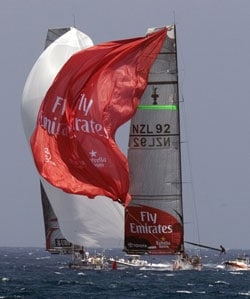
AC07_0629_Main
VALENCIA, Spain-For the second time in three races, the polished, battle-tested team on Emirates Team New Zealand’s NZL-92 suffered a major crewwork disaster. This time, however, in Race 5 of the 32nd America’s Cup, the team couldn’t depend on the wind providing some passing opportunities late in the race as it did in Race 3. Instead of the shifty, puffy conditions of that race, which Alinghi president Ernesto Bertarelli liked to playing craps, Race 5 featured the steady, punchy seabreeze that was predicted when Alinghi chose Valencia to host the America’s Cup three and a half years ago.Nonetheless, Race 5 was every bit an equal of the first four of what could be the most exciting America’s Cup series in history. Despite the crewing disaster, which took place on the first run when Emirates Team New Zealand tried to switch spinnakers after a small tear developed in the one it was flying, the race was extremely close. Emirates Team New Zealand pushed Alinghi all the way around the track, gaining time on the third and fourth legs to finish just 19 seconds behind, and at times closing to within two boatlengths on the final run. If Alinghi has a speed edge in windier conditions, it was not apparent today. Though they would’ve preferred the point and the 3-2 lead in the best-of-9 series, the Team New Zealand sailors were happy to see how well NZL-92 went in the stronger breeze. Alinghi trimmer Simon Daubney talks about how tight this series is, how the pressure is mounting, and what it will take to win the 32nd America’s Cup.The conditions today were absolutely perfect: Bright sun, not a cloud in the sky, and, by the time the race started, a 12- to 14-knot seabreeze. The sailors responded with one of the most entertaining pre-starts in recent memory. ETNZ helmsman Dean Barker, entering on starboard, borrowed a page from Ed Baird’s playbook and ducked out of the dial-up at the last minute, hoping to dive down and come up on Baird’s transom. Baird, then slow on starboard tack was forced up above the line. He tacked to port and high-tailed it for the boat end, hoping to slide over the bow of the New Zealand boat. It was a difficult situation. When that didn’t happen, Baird aimed straight for the press boat and used it as a pick, brushing past the bow while ETNZ ducked the stern. Still Barker was firmly in the control, to leeward with both boats above the layline for the committee boat end. Baird was able to push hard enough to create a little space and then tack at the gun. Alinghi was 5 seconds behind off the line and fairly slow. But the Swiss team was headed toward the side it wanted. ETNZ tacked 30 seconds after the gun and for the second time in two races, we had a speed test to the layline. Once again it was the windward boat that won, herding the leeward boat past the layline for the mark. This time, however, it was ETNZ that was to windward. We’ve got audio quotes from both boats, Ray Davies from Emirates Team New Zealand, and Juan Vila from Alinghi.The fact that NZL-92 was able to hang on the hip of SUI-100, which has shown great height upwind in this regatta, and a purported speed edge over 12 knots, was somewhat surprising. But Team New Zealand did just that. Once NZL-92 was comfortably over layline, Barker spun the boat into a tack and Team New Zealand led around the windward mark by 12 seconds.With Alinghi working low, the run was shaping up to be quite a battle. But then the New Zealand team spied a small tear near the tack kite, and readied for a peel. Just as they were hoisting the new kite, the damaged spinnaker burst apart, nearly knocking Jero Lomas off the pole. The replacement kite appeared to go up OK, but suddenly the tack released and it was flying free. In fact the team had two spinnakers flying from the masthead, neither doing any work and it was out of sheets and halyards. One would have to be retrieved before another could be hoistedThe torn chute was pulled down and a third hoisted-the second flying from the masthead like an oversized windex. The third spinnaker hourglassed on the hoist. By the time it was all sorted out-the second spinnaker left for the chase boat-five minutes has passed and ETNZ’s 60 meter lead and transformed into a 150-meter deficit. Syndicate head Grant Dalton, who also works the sewer on the boat, explains what went wrong here.Remarkably, the ETNZ crew rallied and closed the gap down the rest of the run, rounding the leeward gate-Alinghi taking the right side, ETNZ the left-with a 24-second deficit. Dalton, again, explains how this team was able to refocus so quickly and get back into the race.Up the second beat ETNZ appeared to take little bits out of Alinghi by working the left side. A right shift toward the end favored Alinghi, and the lead around the final mark was 24-seconds. ETNZ hoisted a symmetric spinnaker for the second run, while Alinghi was flying an asymmetric, which is traditionally faster in a straight line, but less maneuverable. ETNZ was quite quick on the run, but never able to get close enough to fully engage the Swiss team. Davies explains what the team tried to do on that final run and why, despite having the more maneuverable spinnaker, they didn’t challenge Alinghi more often. Daubney, from Alinghi, and ETNZ’s Davies both discuss the spinnaker selections they made and what each team hoped to achieve with the choice.









